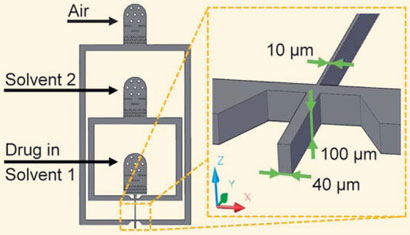 Over the last decade, the molecular complexity of drugs has increased significantly, leading to poor solubility, which means that the compounds can’t be used in the human body. To determine if new formulations have potential as successful drugs, solubility tests are run at an early stage of development. However, the amount of drug available for these tests is usually very small.
Over the last decade, the molecular complexity of drugs has increased significantly, leading to poor solubility, which means that the compounds can’t be used in the human body. To determine if new formulations have potential as successful drugs, solubility tests are run at an early stage of development. However, the amount of drug available for these tests is usually very small.
One way to get around this problem is by decreasing the compounds’ particle size. David Weitz from Harvard University, Cambridge, US, and colleagues, have done just that by developing a microfluidic device made from poly(dimethylsiloxane), incorporating two flow-focussing streams and a third for compressed air to form a spray, that can generate particle sizes below 100nm.
To find out more read Rebecca Brodie’s Chemistry World article or download the article itself here:
Early development drug formulation on a chip: Fabrication of nanoparticles using a microfluidic spray dryer
Julian Thiele, Maike Windbergs, Adam R. Abate, Martin Trebbin, Ho Cheung Shum, Stephan Förster and David A. Weitz
Lab Chip, 2011, Advance Article
DOI: 10.1039/C1LC20298G










